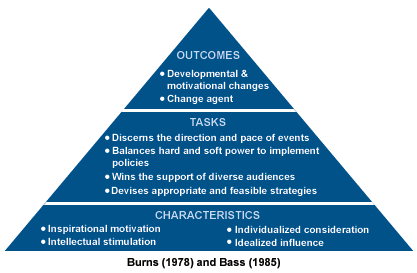Successful Leaders Measure Outcomes
Many leaders struggle with leading people effectively. While I come across many different issues one which is prominent is that leaders do not set the right environment for people to work within. Too often leader's focus on outputs, not on outcomes. The challenge that leaders struggle with is in creating a results focus cultural attitude that measure outcomes instead of outputs.
So what is the difference between an outcome and an output? Why does that matter and why is it difficult to differentiate between the two? And finally why is it crucial for leaders to focus on key results measures of outcomes and not just outputs?
I recently had a client who called me in because his sales team were not following the sales process they needed to undertake. Each one of them has developed their own way of doing through the procedure, reinventing it or tweaking it (their words) to make it work for them. They were all busy doing things and their management and leadership teams could see the stress on the workload, the impact on the processes and on the customers, and on the results. Working with them I could see that they were focused on being busy creating new steps and explaining why things could not be done when the customer wanted. The team had become busy being busy, but not focused on the customer, and the management response was to look at how busy they were through CRM micromanagement, which demotivate the team and the support functions rather than focus on what they were achieving.
This is the challenge for leaders. They deploy a plan and step back and mange outputs through CRM KPI's, not on outcomes for the business, the employees or the customer. Here's this issue visualised in a chart by Burns and Bass, outputs v outcomes.
Outputs vs Outcomes
An output is something that people do, while an outcome is something that happens as a consequence of that doing activity. “I have made 50 calls to prospective customers” is an output, “I’ve closed a new customer” is an outcome. Which one is more important?
Measuring the activity, the output, tells you how busy someone is, while measuring the outcome, the result tells you have effective they have been at the task in hand. Outputs, being busy always start out as the simplest measure to activity, but they are a false measure of success. Outputs are activity measures, while important in their own right, they are not what leaders should be measuring, these are measures which management should measure activity through.
A strategic thinking leader might ask to their line manager, “Why have you made 50 calls and not generated new customer from those calls? What are you saying to people?”
Being busy is simple; being effective is what matters for a successful leader. Strategic leaders focus measuring outcomes towards the end goal. Effective leaders start with the end in mind, measure what matters, is what differentiates successful leaders in leading their organisation from others.
Most people naturally focus on outputs, being busy. It’s relatively easy to come up with a list for what you need to do today, this week and this month. However, as Stephen Covey explains in his book The 7 habits of highly effective people, outputs always come last. In order to be successful, you need to start with the end in mind, by focusing on the outcomes you want, and then work backwards to outputs that lead to the outcome(s) you are focusing on.
For example if you want a new customer, that is a outcome. How you achieve that is to identify what are the steps to getting a new customer.
1. Defining a target audience.
2. Prospecting that audience with a call to identify likely suspects
3. Gain a meeting with suspects, present a solution / offer.
4. Close the sale and confirm the customer is on-board.
5. Pass onto the customer retention team and start again.
The objective, one new customer is a clear outcome. The outputs to get there, steps 1 to 4 above are all activity-based outputs, which the team focuses on delivering towards that outcome. The outputs are measurable activities, which are supported by operational initiatives, such as who is going to do what to deliver them.
Leadership Strategic Approach
- Where do I want to go? Is an OBJECTIVE: the outcome.
- What are the results that lead us to achieve in order to get there? KEY RESULTS outputs towards the outcome, steps 1 to 4 above.
- What do other people need to do to achieve those results? Theseare the operational INITIATIVES, task activities.
If leaders start with activities (i.e. the Initiatives) they take themselves out of control of where they are going. Leaders must focus on the objective, the outcome to be accomplished. Anyone can be operationally busy, but it leaves the operation unfocused on the end objective. Initiatives such as writing the script, recording the stages in the CRM system and who to call back are all operational activities, which are important to achieving the objective, but are overseen by the management not the leadership.
Successful leaders define the outcome and resource the outputs to their management team and then focus on leading the team to achieving the outcome.
Activity-based or results-driven?
Leaders must obsessively focus on the objective, from its inception through to its completion. By focusing on the outcome leaders, lead their people relentlessly towards the objective. Define the outcome you want to achieve before you define the outputs that will get you there.
For many leaders, focusing on outcome achievement instead of outputs requires a significant shift in culture and thinking. Defining outputs is easy, focusing on doing things. Doing something makes people feel good, but doing the wrong thing can still feel good until someone steps back and sees that they have not moved towards the objective, they have just been busy.
Doing things to achieve a specific outcome is a lot more complicated, and now success is not measured anymore by, being busy or by the percentage completion of your output, but by progress towards the end goal.
This shift can be a challenge for many leaders, but the results demonstrate the consequences of your actions and learn what you can do to achieve certain results. The faster you learn, the better you get, as an individual, a team, and a company.
Leaders must measure performance towards objectives within your business? Are you activity-focused or results-driven? Are you happy when 50 prospects or 100 prospects have been called this week or is what really matters to you how many customers you closed? The latter measure of outcome achievement is more informative to the business KPI than the former. As long as Key Results are on track, leaders should not get involved at the Initiative-level. If the business is off-track, then it is sensible to review the initiatives with the relevant management and operational staff to ensure they have a clear output plan that supports the objective outcome. This is where leaders can help the team to figure out what or why it’s not working, and brainstorming what other initiatives we could try to get things back on track.
KPI’s: measure outcomes
KPI’s (Key Performance Indicators, just in case you don’t know) are the reporting indicators which drive decision making. For KPI’s to drive business results then they must indicate outcome performance, not work rate outputs.One big advantage for leaders of measuring outcomes rather than outputs is that it enables them to step back and allow management to manage more effectively. Giving space for managers to manage, removes the accidental tendency to micromanage operations. The risk for leaders in any organisation is that they struggle to define where they should get involved and where they should not. By stepping back leaders can retain their overview rather than being drawn into operational activity.
Summary
To improve your organization, then leaders need to focus the whole team on outcomes instead of outputs. Focusing on outcomes puts the end in mind first, tracks the progress of what really matters, and enables the leadership to learn about company capabilities.
Focusing on outcomes will not only boost performance, but it is also a natural protection against micro-management. Don’t tell sales reps how many outbound calls they need to make today (output), instead make them responsible for closing a certain amount of customers each month (outcome).
Like to learn more about leadership? Then buy the book Strategy: the Leader's Role by Richard Gourlay
Like to learn more about leadership? Then buy the book Strategy: the Leader's Role by Richard Gourlay




















